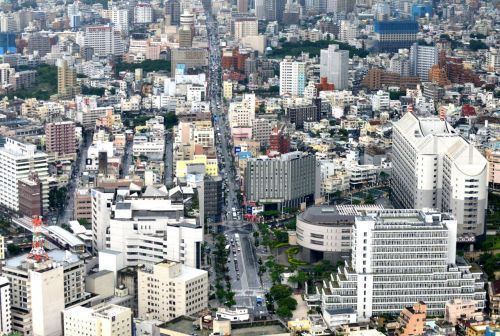Okinawa found to be 4th lowest rank prefecture in Japan in terms of degree of independence

Okinawa's business district
October 18, 2019 Ryukyu Shimpo
On October 17 it came to light through an investigation by Emeritus Professor Hajime Oshiro of the University of the Ryukyus that the regional economic circulation ratio within Okinawa Prefecture is 78.8 percent, which demonstrates that the degree of independence of the local Okinawan economy is the 4th worst ranked within Japan. The “leak rate” of 21.2 percent represents the money that does not remain in the region but outflows from the region, which is calculated to account for 1,010.5 billion yen outflowing from Okinawa.
Professor Oshiro’s calculations are based on the FY2013 numbers from the Regional Economy and Society Analyzing System (RESAS). According to Professor Oshiro, Okinawa produced 4,761.5 billion yen in FY2013, but the final demand only amounted to 3,751.0 billion yen.
In order of degree of independence, the national worst ranked prefecture was Iwate Prefecture with a regional economic circulation ratio of 75.5 percent and a leak rate of 24.5 percent, the second-worst ranked was Nara Prefecture with a circulation ratio of 76.2 percent and a leak rate of 23.8 percent, and the third-worst ranked was Saitama Prefecture with a circulation ratio of 77.7 percent and a leak rate of 22.3 percent.

Okinawa’s business district
Those prefectures with the highest circulation rates were greater metropolitan areas. The prefecture with the highest circulation rate was Tokyo Prefecture at 154.2 percent, followed by Osaka Prefecture at 108.0 percent and Aichi Prefecture at 106.8 percent. The results show that regional economic activity tends to flow into metropolitan areas.
Professor Oshiro pointed out that: “21.2 percent of Okinawa’s finance leaks out of the prefecture. Its condition as a ‘zaru economy’ has not improved, and it is still mid-way to being a self-sustaining economy.”He also emphasized: “Money comes into Okinawa Prefecture, centered in industries related to tourism, but Okinawa cannot retain it. There are requests for efforts toward local consumption of local product, in other words toward products used locally being locally produced.”
Data such as the populations of various regions on the map, regional economic circulation maps, and industrial structures are available through the RESAS, which was created by the Ministry of Economy, Trade and Industry (METI) and the Cabinet Office.
Translator’s note: A “zaru economy” might be loosely translated as a “sieve economy,” meaning money earned in the region does not penetrate into the region’s economy, but flows out of the region.
(English translation by T&CT and Erin Jones)
Previous Article:Orix Buffaloes select Konan High School’s Hiroya Miyagi with their first pick in the draft; “I want to return the favor [of support] to my hometown.”
Next Article:MASA MAGIC wins international magic competition for second time
[Similar Articles]
- Okinawa has highest poverty rate in Japan
- University of the Ryukyus contributes 69.4 billion yen to economy
- Tourism generates 676.7 billion yen in economic ripple effect
- A 14 percent increase in tourism-related economic effect, record high at 1.17 trillion yen
- Okinawa’s birth rate the highest in Japan for 37 consecutive years and divorce rate is also top, but marriage rate comes second
 Webcam(Kokusai Street)
Webcam(Kokusai Street)


